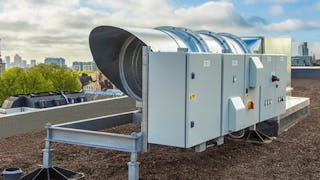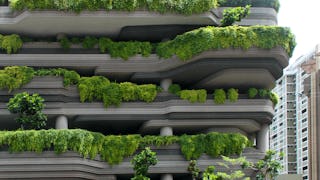The course provides a comprehensive overview of sustainability in construction, emphasizing the depletion of natural resources, global energy utilization, and challenges faced. It explores site selection parameters, the impact on the environment, and methods for preserving site resources. The integrated design approach and its benefits are discussed, along with the importance of basic amenities and the urban heat island effect. The course covers various aspects of building environmental considerations, focusing on heat transfer, thermal and visual comfort, and sustainable building practices. Heat transfer is explained through conduction, convection, and radiation, with a specific emphasis on heat gain in buildings, both internal and external. The discussion extends to thermal comfort, considering factors influencing human perception of heat and cold, and includes models for air-conditioned and non-air-conditioned spaces. Visual comfort is explored in terms of lighting design, covering daylighting strategies and artificial lighting parameters in compliance with building codes.


Comfort in Buildings
3,877 人已注册
包含在 中
您将学到什么
Understand the fundamentals of sustainable construction and gain knowledge on sustainable site selection and preservation of site resources.
Evaluate the heat transfer through building elements and provide solution for avoiding heat ingress in the buildings.
Understand the key parameters of psychrometry, thermal comfort and analyze thermal comfort models
您将获得的技能
要了解的详细信息

添加到您的领英档案
4 项作业
了解顶级公司的员工如何掌握热门技能

积累特定领域的专业知识
- 向行业专家学习新概念
- 获得对主题或工具的基础理解
- 通过实践项目培养工作相关技能
- 获得可共享的职业证书

该课程共有4个模块
The module offers a comprehensive overview of sustainability, highlighting its significance and the challenges encountered in the field of construction. It delves into the depletion of natural resources resulting from human activities, analyzes global energy consumption across various sectors, and anticipates future energy demands in India, all while exploring diverse energy sources. The discussion encompasses criteria for site selection, emphasizing its importance and examining various types of sites and their environmental impacts. The module also imparts knowledge on strategies for preserving site resources such as topsoil, water bodies, and plantations. Additionally, it provides a concise introduction to the integrated design approach, aligning project requirements with its associated benefits. The importance of basic amenities in proximity to buildings and an exploration of the urban heat island effect are also included in the discourse.
涵盖的内容
12个视频1篇阅读材料1个作业
Heat transfer involves the exchange of thermal energy between two distinct systems. The principles of thermodynamics elucidate the modes of heat transfer, namely conduction, convection, and radiation. This module focusing on heat transfer within buildings provides an overview of internal and external heat gain. External heat gain, originating from building components like roofs, walls, fenestration, as well as through ventilation and air leakage, is thoroughly explained, accompanied by examples and precise calculations of the heat absorbed by these elements. Additionally, the reasons behind internal heat gain in a building are explored, along with the determination of the heating and cooling loads necessary to condition a space for the occupants' comfort.
涵盖的内容
16个视频1个作业
Thermal comfort pertains to the subjective sensation experienced by the human body resulting from the influence of heat and cold sources in the surrounding environment. This module commences with a fundamental introduction to thermal comfort, elucidating the key parameters that shape its perception. The module also explores factors contributing to local thermal discomfort. Psychrometry, the study of thermodynamic properties of air and water vapor mixtures, is comprehensively explained using a psychrometric chart. The application of psychrometry in processes such as heating, cooling, humidification, and dehumidification is detailed, accompanied by illustrative examples. Thermal comfort models are examined for both air-conditioned and non-air-conditioned spaces.
涵盖的内容
9个视频1个作业
Visual comfort encompasses an individual's response to the lighting conditions within a space, characterized by adequate illumination, contrast, color, and the presence or absence of glare. This module on visual comfort introduces the fundamentals of lighting and the terminology employed in lighting design. Strategies for both daylighting and artificial lighting within a building are elucidated. The module delves into the aspects of daylighting for buildings, offering a detailed explanation of daylighting control strategies. Additionally, it outlines the various types of artificial lighting based on tasks. The design of artificial lighting is explored, and the necessary parameters, in accordance with the provisions outlined in the National Building Code (NBC), 2016, and the Energy Conservation Building Code (ECBC), are elaborated upon with the aid of examples.
涵盖的内容
14个视频1个作业
获得职业证书
将此证书添加到您的 LinkedIn 个人资料、简历或履历中。在社交媒体和绩效考核中分享。
位教师

提供方
从 Environmental Science and Sustainability 浏览更多内容
 状态:免费试用
状态:免费试用 状态:预览
状态:预览Indian Institute for Human Settlements
 状态:免费试用
状态:免费试用 状态:免费试用
状态:免费试用Johns Hopkins University
人们为什么选择 Coursera 来帮助自己实现职业发展




常见问题
To access the course materials, assignments and to earn a Certificate, you will need to purchase the Certificate experience when you enroll in a course. You can try a Free Trial instead, or apply for Financial Aid. The course may offer 'Full Course, No Certificate' instead. This option lets you see all course materials, submit required assessments, and get a final grade. This also means that you will not be able to purchase a Certificate experience.
When you enroll in the course, you get access to all of the courses in the Specialization, and you earn a certificate when you complete the work. Your electronic Certificate will be added to your Accomplishments page - from there, you can print your Certificate or add it to your LinkedIn profile.
Yes. In select learning programs, you can apply for financial aid or a scholarship if you can’t afford the enrollment fee. If fin aid or scholarship is available for your learning program selection, you’ll find a link to apply on the description page.
更多问题
提供助学金,



